
My garden is a hot mess.
I’m pleased to say that the reason I’ve been neglecting it is because I’ve been working on a book with my horticultural hero, Paul Bonine of Xera Plants. The book is tentatively called The Homeowner’s Guide to Gardening in the Pacific Northwest, and it will be released next year by Timber Press.
However, the garden. Summer is when the rains come to a screeching halt in Portland. This year we got less than two and a half inches of rain for all of June, July, and August. Temperature-wise, it was mild, though we did have a couple of hot spells, with a few 100-degree days.
And all I did for the garden was to water it enough to keep (most) things alive. It turned out to be a great experiment. After all, I’m getting ready to plant the front garden and I want tough, ultra-drought-tolerant stuff out there that I don’t have to baby. Here’s what I learned. I give you the winners and losers of Summer Drought 2016:
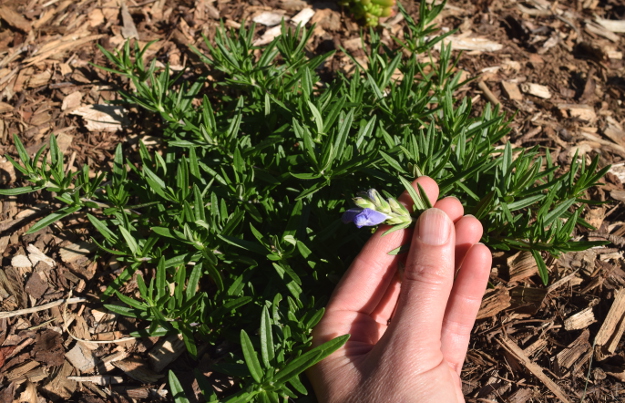
Dragon’s head (Dracocephalum argunense) still has perfect, glossy, deep green leaves to show that there are no hard feelings from my weeks of utter neglect. It’s even trying to spit out a couple of its namesake dragon’s head (if you really squint) flowers. The main floral show is in late spring and early summer.
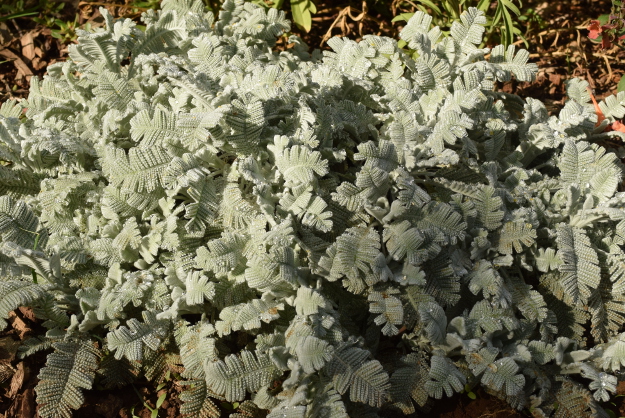
Silver tansy (Tanacetum haradjanii) made it clear that it could live without me, but I don’t know if I could live without it. My friend Matthew at The Lents Farmer gave me this start in the spring and it has bulked up nicely, even though I’ve barely watered it or shown it any love other than to tell it how beautiful its soft, feathery foliage is.

Matthew also gave me some seeds from his variegated sea campion (Silene uniflora). Naturally, the variegation wasn’t passed on to the seedlings, but foliage is still pretty neat—it’s kinda rubbery, almost succulent, which may explain its drought tolerance. For some reason, I thought this was a pink-flowering plant and wouldn’t go with my color scheme, so I only saved one plant and threw it in a holding bed. But it has a lovely white flower and now I want it everywhere.
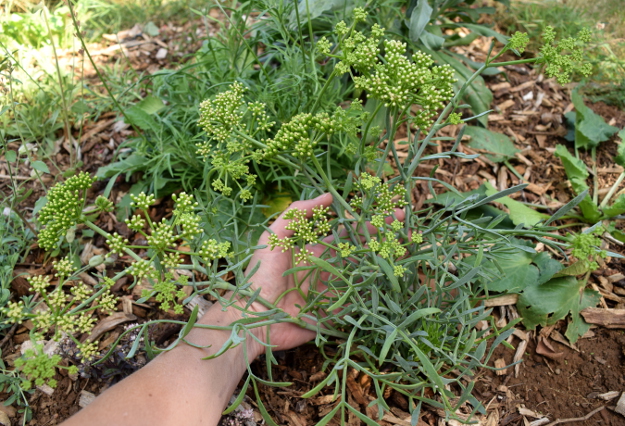
Rock samphire (Crithmum maritimum) is new to me; I got it at Xera Plants this year. It’s a cool-looking plant, and I’m impressed with its drought tolerance. It’s in a bit of shade here (not where it wants to be) and is growing into a Scabiosa ochroleuca that I grew from seed (another plant I’m impressed with), so I’m pulling it away from its neighbor so you can see it better. I didn’t think it would flower this year, but hello! Hoping for lots of ripe seed and then I’ll make more Crithmum babies. The plant is edible; I’ve sampled it and it has a mild, carroty flavor.

Stachys lavandulifolia is another Xera find. It gets super-fluffy lavender flowers in late spring and early summer. The foliage is nice, too.
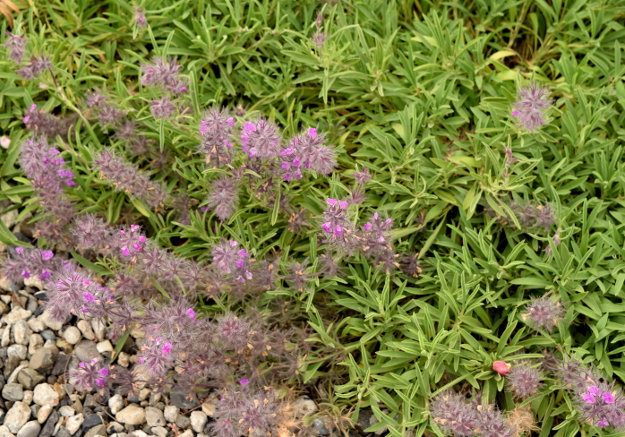
I spotted it at Blooming Junction in early June in flower in the gravel garden there.

I’m not sure if this will get weedy and I’ll regret it, but we’ll see. I plugged a bunch of little things into my shady rock wall earlier this year to see what would survive in the nooks and crannies. This is an annual/biennial Corydalis relative called Capnoides sempervirens. It gets sweet little pink and yellow flowers. And the foliage is mighty fine.
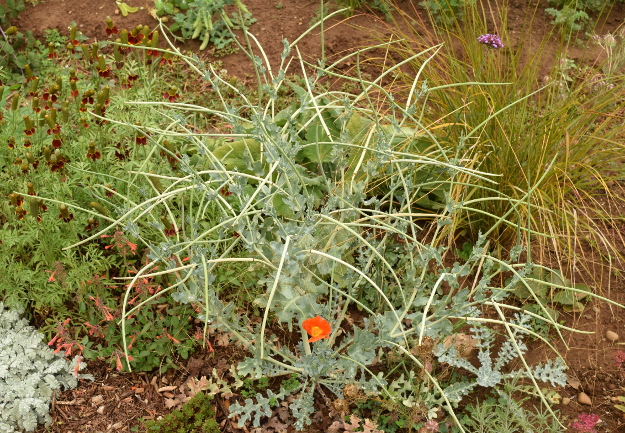
I direct-sowed a bunch of these horned poppies (Glaucium flavum var. aurantiacum) in the spring, but we got April monsoons instead of April showers and they all rotted except for this one plant and the runt to the right. I like this orange variety much better than the usual yellow version. Aren’t the seedpods fun? Behind to the left is Ratibida columnifera, which isn’t supposed to bloom the first year from seed, but it did anyway and I was tickled. I did give that patch some mulch and extra water. The grass to the right is Anamanthele lessoniana. It’s drought tolerant, but just kind of meh in the looks department.

I felt silly buying a Sedum rupestre, a.k.a. S. reflexum when I went to Blooming Junction this summer, since any gardener will give you armloads of it to you for the asking, but Blue Bird is no ordinary Sedum rupestre! It’s the dreamiest color—almost turquoise. It really stood out on the nursery bench, and the color didn’t change when the plant was in the ground (you know how some plants don’t hold their color in the landscape). This one’s a bit roughed up because I did let a lupine crowd it and overshadow it.
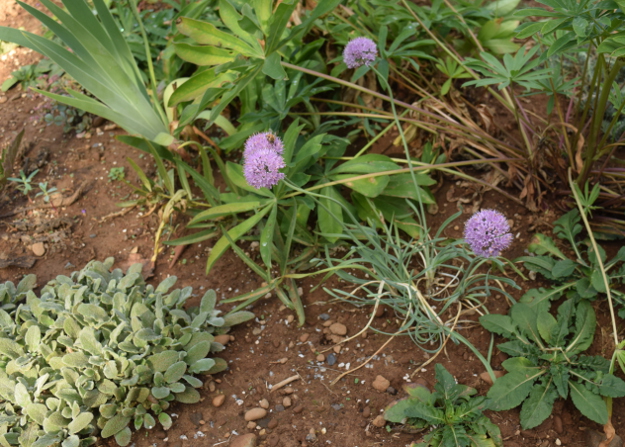
I also got an Allium senescens subsp. glaucum at Blooming Junction. This ornamental onion has swirly blue foliage and bee-friendly pink globes that bloom now. The flowers smell like stinky feet, but only if you stick your nose right in them. This is a cute plant. You’ll have to imagine that it, too, hadn’t been shaded by a lupine for too long. To the left is an adorable mini lamb’s ear I also got from Blooming Junction called Stachys byzantina ‘Silky Fleece’. Both doin’ great on neglect.

It’s no surprise that Euphorbia characias subsp. wulfenii is flourishing despite my lack of attention, but I include it because I am especially pleased with it this year. It was glorious in late winter and spring and bloomed forever, but it was just so honkin’ HUGE. Magnificent, but crazy-big. So I cut it back hard. Really hard. There were a lot of shoots coming up from the base—I wasn’t too worried. And it filled in quickly and so neatly! So don’t be afraid to cut this one back. My other euphorbias are rock-solid for drought, too—E. rigida, E. myrsinites, and E. ‘Blackbird’.
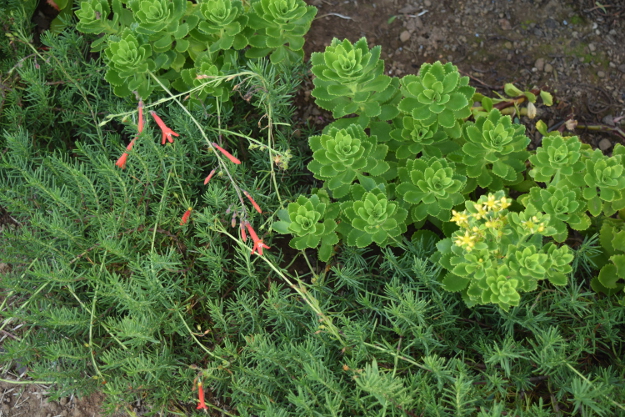
When I cut my big euphorbia back, a gap opened up, which I filled with Sedum takesimense. This mid-sized sedum has neatly scalloped, apple-green leaves and yellow flowers in geometric patterns in summer. It gets woody at the base and leafs out in late winter here, so it’s basically an evergreen. Very cool and underutilized. The plant next to it also sailed through the drought and my mistreatment—pineleaf beardtongue or Penstemon pinifolius, if you prefer. It looks like a creeping conifer but puts up all these little scarlet hummingbird feeding tubes in summer.
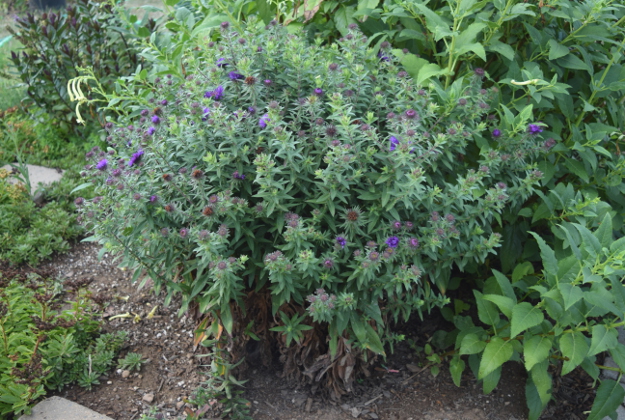
I’m floored by ‘Purple Dome’ aster (Symphyiotrichum novae-angliae ‘Purple Dome’). I mean, this is a plant of moist meadows in the East! It’s in bone-dry soil next to a water-sucking phygelius, and it looks great. Just a little bare at the ankles, which could be solved with a low groundcover and a drink now and then.
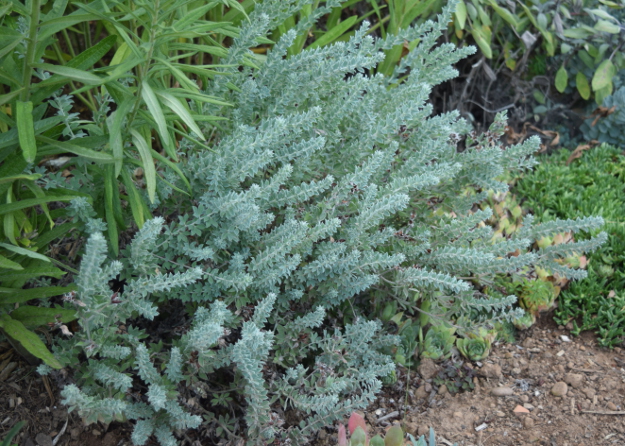
Love me some hairy canary clover (Dorycnium hirsutum). It gets pretty white flowers, but the pettably soft foliage is primarily why it’s grown. This is a low-growing form I started from seed. From what I hear, it will reseed prolifically without any help. It needs dry soil and full sun and is short lived.
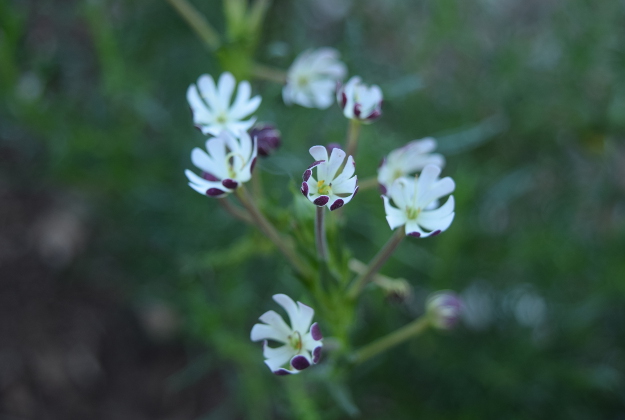
Night-blooming phlox (Zaluzianskya capensis) is usually grown as an annual. I didn’t sow any this year, but a couple of plants overwintered in our sissy zone 9 winter last year, and they also survived Summer Drought 2016 just fine. They open in the evening and smell like talcum powder. Paul thinks they smell like Pez candy. They’re precious.

And now for the failures… Monarda fistulosa. I keep getting nostalgic and trying to grow plants that I loved in Cincinnati, and some of them don’t work here. M. fistulosa wants more water than I’m willing to give. I know it has that nice autumnal seedhead look in the photo, but it shouldn’t look like that in summer, and it did. I just let it die. There are way cooler things I can grow.

Ditto candy lilies (Iris ×norrisii). I even posted about them here! I loved them in Cincinnati, but in Portland, they need more irrigation than I care to supply, they don’t bloom long enough for me, and the flowers aren’t open long enough during the day. Several of the seedlings I grew were floppy, too, though the floppiness I could deal with if they were worth the trouble to stake.
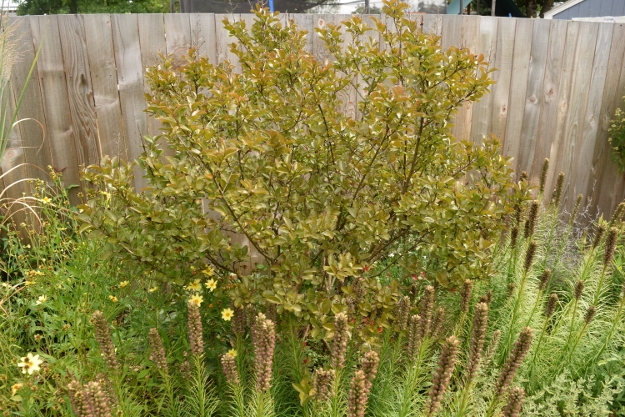
This is my ‘Tonto’ crape myrtle. I didn’t water it, so it looks off-color, it didn’t bloom this year, and it didn’t grow. In fact, I think it even got smaller, if that’s possible. I naively thought that crape myrtles were drought tolerant here, but they do require water to perform well. I may yank it out and replace it with something less demanding. Don’t tell Paul. The ‘Kobold’ liatris surrounding it, however, really surprised me. It didn’t show drought stress until August. This is a midwestern prairie plant that I’d assumed would need fairly regular water, but it’s been amazingly self-sufficient.
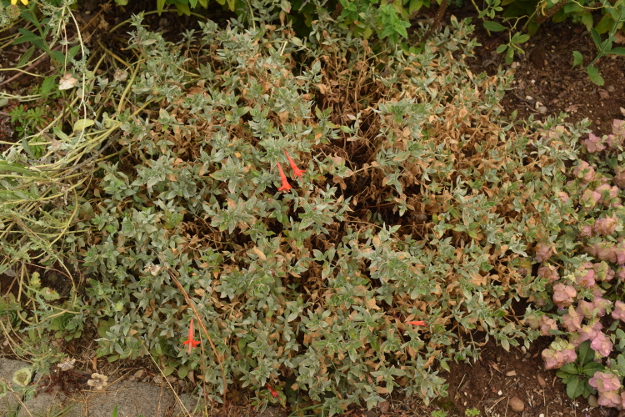
This is a mystery to me. California fuchsia (Epilobium septentrionale) is supposed to be the poster child for drought-tolerant plants. It looked perfect until it was time to bloom—then it did this. It did this last year, too. Any thoughts?
Have you ever been a derelict gardener? What lessons did you learn about your plants?


Oh man! That Sedum takesimense you gifted me with in the spring has gotten positively buried by a happy Echium, thank you for the reminder to rescue it.
Hey, it’s letting you post! WordPress must have decided you were all right after all. Let me know if you ever need any Sedums – I am your source.
You know why? (comment) Because I finally realized that unlike every other WordPress blog yours wasn’t happy with the autofill option for website. Instead of http://www.thedangergarden.com being good enough it needed http://www.thedangergarden.com/…silly!
And don’t tempt me with the Sedum, I might take you up on that.
Now you’re confusing it again. It made me moderate that one!
This is a useful run-down of interesting, drought tolerant plants. I’ve actually been a worse gardener than you. I watered a couple of beds once (really, once) all summer. The rest not at all. My garden is looking pretty crisp. I’m wondering what’s alive and what’s really dead. I might not know until next year.
Wow, you will truly separate the men from the boys! Did you send the Pelargonium sidoides down with Peter for the swap? I nabbed a couple of those and they are doing well despite my abuse. And your irises are on the patio getting special treatment.
Amy, I try to water well all summer. However, there is one spot next to my neighbor’s property, and they always store things right there. So, this spot gets no water at all, ever! Wild asters grow and bloom year after year there, as does evening primrose. Recently planted Russian sage gets a little bit of water and flourishes. Mullein plants itself and grows readily, although I pull the plant in its youth. ‘Autumn Joy’ sedum expands in the waterless zone and expands year after year. Beautyberry (Callicarpa) ‘Profusion’ gets a tiny bit of water, readily blooms, and creates its incredibly-colored berries year after year
I have an evening primrose, but it is still getting established, so it wilts if I don’t water it. I propagated some Russian sage, but it’s still in pots, and the mullein is awaiting planting, too. I have a small Profusion beautyberry in a holding bed, but it may have bit the dust, because it got no love.
Amy, your result for Zauschneria is a little confounding. This has always been a stellar performer for me at home and in Parks. Not sure what’s up with yours unless its crowded or shaded by neighbors. The Crape Myrtle too, I know prefer a little summer water here, but for example, my neighbor has several 20+ footers in their south parking strip, I don’t know the varieties and the plants are vigorous and bloom well without getting spit for extra water. How long and well established is yours? Established tree forms will have deeper roots more extensive roots systems and are no doubt more drought tolerant. You mentioned ‘thirsty’ Phygelius….I grew Phygelius aequalis in my parking strip at the base of a Stop Sign with little to no water after an establishment year. It was vigorous and floriferous. Not all Phygelius are created equal. Some plants are too successful. I have almost eliminated the drought tolerant Euphorbia as they also tended to seed in aggressively and I got tired of pulling them. It is interesting how what is successful for one gardener isn’t so much for another!
The crape myrtle was the first thing I planted in that bed, in fall of 2014. It flowered nicely last year and had beautiful fall color, though I did water. I have seen a lot of crape myrtles here that look terrible and a lot that look gorgeous, so I like them but haven’t wholly embraced them. Euphorbias I am cautious about after Euphorbia stricta went to seed and made a carpet of seedlings that I’m still pulling up two years later, but the better-behaved ones can be so valuable.
Very interesting. This rainless summer has really made me re-think some of my future plant choices. Although I water faithfully and my plants did not die, many just did not seem to grow that much. I may be underwatering (once per week, about an inch) so perhaps I should do it more often. The ‘Purple Dome’ aster is on my wish list. Is it easy to find locally? I want to try the eurphoria too.
An inch a week is plenty! I think you will be surprised how much everything grows next spring. I got the Purple Dome from a friend and can pass a piece along to you. The euphorbia does seed around a bit and I can save some seedlings for you, but they’ll be tiny.
Thanks Amy! That will be awesome!
It’s always interesting to see what survives a drought or deluge. I’ll take the plants that can handle any extreme. Dracocephalum is really tough. If I have a spot, I’m going to add some to my garden.
As I was writing this, I was thinking that people in the East and the South, and even the Midwest, wouldn’t know what I was talking about by saying there was a drought this summer. The other extreme for sure. Dracocephalum was new to me this year – I look forward to seeing the floral show next spring.
[…] Favorite 2016 Post: Summer Drought 2016 Winners and Losers […]